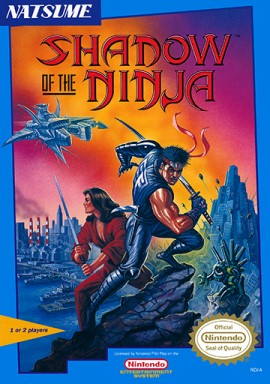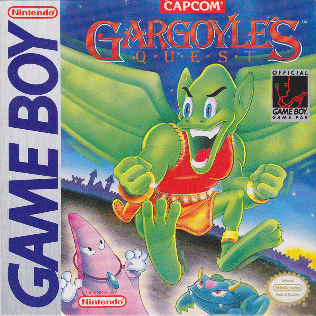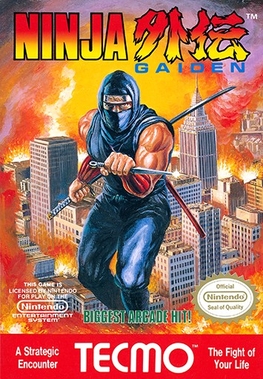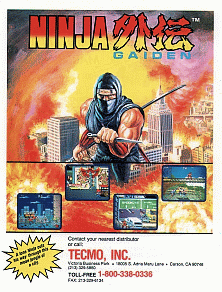
A platformer is a sub-genre of action video games in which the core objective is to move the player character between points in an environment. Platform games are characterized by levels with uneven terrain and suspended platforms of varying height that require jumping and climbing to traverse. Other acrobatic maneuvers may factor into the gameplay, such as swinging from vines or grappling hooks, jumping off walls, gliding through the air, or bouncing from springboards or trampolines.
Ninja Gaiden is a media franchise based on action video games by Tecmo featuring the ninja Ryu Hayabusa as its protagonist. The series was originally known as Ninja Ryukenden in Japan. The word "gaiden" in the North American Ninja Gaiden title means "side story" in Japanese. The original arcade version, first two Nintendo Entertainment System games and Game Boy game were released as Shadow Warriors in PAL regions. As of 2008, the series has shipped over 7.7 million copies.

Hagane: The Final Conflict is a 1994 action-platform video game developed by CAProduction and published by Red Entertainment and Hudson for the Super Nintendo Entertainment System. The player takes on the role of a ninja cyborg named Hagane on his path to take revenge on an opposing ninja faction. The game combines traditional Japanese ninja and samurai aesthetics with a futuristic setting. The player has a wide variety of weapons, moves, and attacks at their disposal to defeat enemies and progress through the game. Hagane released to positive reception, and was compared favorably to classic side-scrolling action games. Reviewers praised the controls, art design, and challenge but criticized the quality of the graphics and sound.

Ninja Gaiden II: The Dark Sword of Chaos, known in Europe as Shadow Warriors II: The Dark Sword of Chaos, is a side-scrolling platform game developed and published by Tecmo for the Nintendo Entertainment System (NES). This is the second installment in the Ninja Gaiden trilogy for the NES and was released in North America and Japan in 1990, and in Europe in 1992. An arcade video game version was also introduced by Nintendo for their PlayChoice-10 system in 1990.

Ninja Gaiden III: The Ancient Ship of Doom is a side-scrolling platform video game developed and published by Tecmo. It was released in Japan on June 21, 1991 for the Famicom and in North America on August 1991 for the Nintendo Entertainment System (NES). The NES version was not released in Europe. It was later ported to the Atari Lynx by Atari Corporation and released in 1993 in North America and Europe, the European version retaining the North American Ninja Gaiden III title. It was also re-released as part of its Ninja Gaiden Trilogy Super NES compilation in 1995 in Japan and North America. Long after, it was released for the Virtual Console service in North America on February 18, 2008 for the Wii and in North America and Europe on November 28, 2013 and January 23, 2014 respectively for the Nintendo 3DS. It was designed by Masato Kato, who took over for Hideo Yoshizawa—designer of the first two games in the NES series.

Cave Story is a 2004 Metroidvania platform-adventure video game for Microsoft Windows. It was developed over five years by Japanese independent developer Daisuke "Pixel" Amaya in his free time. Cave Story features 2D platform mechanics and is reminiscent of the games Amaya played in his youth, such as Metroid and Castlevania. After its initial self-published release, the game slowly gained popularity on the internet. It received widespread critical acclaim for many polished aspects of its design, such as its compelling characters, setting, story, and gameplay. Cave Story is considered by many as the quintessential indie game because of its one-person development team and influence on the video gaming world.

Shadow of the Ninja, originally released in Japan as Yami no Shigotonin Kage and later released in Europe and Australia as Blue Shadow, is a side-scrolling action game developed by Natsume for the Nintendo Entertainment System (NES) in 1990. The game revolves around a pair of ninja sent to assassinate a dictator in a futuristic version of New York City. A port was planned for the Game Boy, but was released in a rebranded form as Ninja Gaiden Shadow.

Team Ninja is a Japanese video game developer, and a division of Koei Tecmo, founded in 1995 as a part of Tecmo. It was founded by Tomonobu Itagaki, and is best known for franchises such as Ninja Gaiden, Dead or Alive and Nioh.
A beat 'em up is a video game genre featuring hand-to-hand combat against a large number of opponents. Traditional beat 'em ups take place in scrolling, two-dimensional (2D) levels, while a number of modern games feature more open three-dimensional (3D) environments with yet larger numbers of enemies. The gameplay tends to follow arcade genre conventions, such as being simple to learn but difficult to master, and the combat system tends to be more highly developed than other side-scrolling action games. Two-player cooperative gameplay and multiple player characters are also hallmarks of the genre. Most of these games take place in urban settings and feature crime-fighting and revenge-based plots, though some games may employ historical, science fiction or fantasy themes.

Gargoyle's Quest is an action-adventure platform game developed by Capcom for the Game Boy and released in 1990. It is a spin-off of the Ghosts 'n Goblins series, featuring the series antagonist character Firebrand as the main playable character. Gargoyle's Quest was followed by the NES prequel Gargoyle's Quest II in 1992 and the Super NES sequel Demon's Crest in 1994.

Ninja Gaiden, released in Japan as Ninja Ryūkenden and as Shadow Warriors in Europe, is an action-platform video game developed and published by Tecmo for the Nintendo Entertainment System. Its development and release coincided with the beat 'em up arcade version of the same name. It was released in December 1988 in Japan, in March 1989 in North America, and in August 1991 in Europe. It has been ported to several other platforms, including the PC Engine, the Super NES, and mobile phones.

Ninja Gaiden, released in Japan as Ninja Ryūkenden and in Europe as Shadow Warriors, is a 1988 side-scrolling beat-'em-up game, originally released by Tecmo as a coin-operated arcade video game. It was first released in North America and Europe in late 1988, and then in Japan in February 1989. It was the first game released in the Ninja Gaiden franchise. The arcade game was a major commercial success in North America, becoming the highest-grossing arcade conversion kit of 1989 in the United States.

Ninja Gaiden is a side-scrolling, hack & slash, platform-action video game developed by SIMS and released by Sega for the Master System in 1992, with license from Tecmo.

Oniken is a side-scrolling action platform video game developed and published by independent Brazilian studio Joymasher for Microsoft Windows, OS X and Linux. The game was released worldwide for Microsoft Windows on June 21, 2012, on OS X and Linux on November 20, 2012, and on Nintendo Switch on February 1, 2019 as Oniken: Unstoppable Edition. In August 2012, the developers have announced that the game was accepted on Steam Greenlight.

Metroidvania is a sub-genre of action-adventure games and/or platformers focused on guided non-linearity and utility-gated exploration and progression. The term is a portmanteau of the names of the video game series Metroid and Castlevania, based on the template from Metroid (1986), Castlevania II (1987), Super Metroid (1994), and Castlevania: Symphony of the Night (1997).

Bloodstained: Curse of the Moon is a 2018 platform game developed and published by Inti Creates. It is a companion title to developer ArtPlay's 2019 game Bloodstained: Ritual of the Night and was conceived to fulfill the promise for a retro-style accompaniment to Ritual of the Night after its Kickstarter campaign exceeded crowdfunding goals. Curse of the Moon follows Zangetsu, a cursed swordsman hunting down demons for revenge, as well as three other playable characters named Miriam, Alfred and Gebel. It features an 8-bit aesthetic and gameplay style similar to Castlevania games on the Nintendo Entertainment System (NES), particularly Castlevania III: Dracula's Curse (1989).

Cyber Shadow is a side-scrolling action-platform game developed by Finnish indie studio Mechanical Head Studios and published by Yacht Club Games. Using an 8-bit aesthetic, the game follows a cybernetic ninja named Shadow who sets out to rescue his clan in a world overrun by machines.

Kunai is an action-platform video game developed by TurtleBlaze and published by The Arcade Crew. The game was released on February 6, 2020 for Windows and Nintendo Switch. In the game, the player controls Tabby, a robot tasked with defeating Lemonkus, an AI that nearly causes the extinction of humanity. In July 2020, The Arcade Crew partnered with Limited Run Games to release physical copies of the Nintendo Switch version. The physical copies were released in October 2020. The PC version received generally favorable reviews, while the Nintendo Switch version received mixed reviews.

Sea of Stars is a 2023 role-playing video game by Sabotage Studio. The game was released for Windows, Nintendo Switch, PlayStation 4, PlayStation 5, Xbox One, and Xbox Series X/S and is set thousands of years before Sabotage Studio's previous game The Messenger (2018). In the game, players take control of two heroes named Valere and Zale, who use the power of the sun and moon to fight against an alchemist. Sea of Stars features puzzle-solving and turn-based combat, with the player able to control up to six characters. The game was well received critically and commercially.

Alwa's Awakening is a Metroidvania video game developed by Elden Pixels. It was first released in 2017.


















